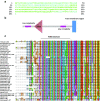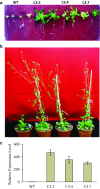Characterization of a novel zinc finger transcription factor (TaZnF) from wheat conferring heat stress tolerance in Arabidopsis
- PMID: 28889352
- PMCID: PMC5823806
- DOI: 10.1007/s12192-017-0838-1
Characterization of a novel zinc finger transcription factor (TaZnF) from wheat conferring heat stress tolerance in Arabidopsis
Abstract
C3HC4-type zinc finger proteins are known to play important roles in various plant processes including regulation of growth and development, signaling networks, responses to abiotic stresses etc. The current study identifies and explores the involvement of TaZnF in plant stress response, mainly heat stress. TaZnF belongs to C4HC3-type zinc finger transcription factor. Phylogenetic analysis of TaZnF revealed strong sequence similarity to Brachypodium distachyon, a model system for crop species. Gene expression studies have revealed its role under diverse stress conditions including heat and cold conditions. The transcript level of TaZnF was found to be highest in seed and starts at the post anthesis period 3-5DAA, a more sensitive stage resulting in a negative influence on the yield of crop species. TaZnF possesses transcriptional activity. Overexpression of TaZnF in Arabidopsis thaliana conferred improved tolerance to both basal and high-temperature stress as observed from various assays examining their growth and development. The transgenics were recovered and showed early flowering compared to wild-type. They had larger primary roots, more lateral branching, bigger, and more numerous leaves, resulting in heavier fresh weight. Enhanced growth and early recovery resulted in bigger plants with more yield. Additionally, the overexpression Arabidopsis transgenics also showed considerable tolerance to cold and oxidative stress. These observations suggest that TaZnF acts as a positive regulator of thermal stress and thus can be of great significance in understanding and improving temperature stress tolerance in plants.
Keywords: C4HC3-type; Cold stress; High-temperature stress; Oxidative stress; RING zinc finger; Triticum aestivum.
Figures











Similar articles
-
Salt tolerance function of the novel C2H2-type zinc finger protein TaZNF in wheat.Plant Physiol Biochem. 2016 Sep;106:129-40. doi: 10.1016/j.plaphy.2016.04.033. Epub 2016 Apr 29. Plant Physiol Biochem. 2016. PMID: 27156137
-
TaZFP 23, a new Cys2/His2-type zinc-finger protein, is a regulator of wheat (Triticum aestivum L.) growth and abiotic stresses.PeerJ. 2025 Feb 17;13:e18956. doi: 10.7717/peerj.18956. eCollection 2025. PeerJ. 2025. PMID: 39981045 Free PMC article.
-
BrRZFP1 a Brassica rapa C3HC4-type RING zinc finger protein involved in cold, salt and dehydration stress.Plant Biol (Stuttg). 2013 Mar;15(2):274-83. doi: 10.1111/j.1438-8677.2012.00631.x. Epub 2012 Jun 21. Plant Biol (Stuttg). 2013. PMID: 22726580
-
Involvement of plant C(2)H(2)-type zinc finger transcription factors in stress responses.Plant Sci. 2012 Apr;185-186:78-85. doi: 10.1016/j.plantsci.2011.11.015. Epub 2011 Dec 2. Plant Sci. 2012. PMID: 22325868 Review.
-
HSP101: a key component for the acquisition of thermotolerance in plants.Plant Cell. 2000 Apr;12(4):457-60. doi: 10.1105/tpc.12.4.457. Plant Cell. 2000. PMID: 10760235 Free PMC article. Review. No abstract available.
Cited by
-
RING Zinc Finger Proteins in Plant Abiotic Stress Tolerance.Front Plant Sci. 2022 Apr 14;13:877011. doi: 10.3389/fpls.2022.877011. eCollection 2022. Front Plant Sci. 2022. PMID: 35498666 Free PMC article. Review.
-
Functional Characterization of Eight Zinc Finger Motif-Containing Proteins in Toxoplasma gondii Type I RH Strain Using the CRISPR-Cas9 System.Pathogens. 2023 Oct 11;12(10):1232. doi: 10.3390/pathogens12101232. Pathogens. 2023. PMID: 37887748 Free PMC article.
-
Dissecting the Molecular Function of Triticum aestivum STI Family Members Under Heat Stress.Front Genet. 2020 Aug 19;11:873. doi: 10.3389/fgene.2020.00873. eCollection 2020. Front Genet. 2020. PMID: 32973870 Free PMC article.
-
The interplay among space, environment, and gene flow drives genetic differentiation in endemic Baja California Agave sobria subspecies.Am J Bot. 2025 Jul;112(7):e70062. doi: 10.1002/ajb2.70062. Epub 2025 Jul 2. Am J Bot. 2025. PMID: 40605264 Free PMC article.
-
Distinctive in-planta acclimation responses to basal growth and acute heat stress were induced in Arabidopsis by cattle manure biochar.Sci Rep. 2021 May 10;11(1):9875. doi: 10.1038/s41598-021-88856-7. Sci Rep. 2021. PMID: 33972570 Free PMC article.
References
-
- Abu-Romman S. Molecular cloning and expression analysis of zinc finger-homeodomain transcription factor TaZFHD1 in wheat. S Afr J Bot. 2014;91:32–36. doi: 10.1016/j.sajb.2013.11.014. - DOI
-
- Bajji M, Kinet JM, Lutts S. The use of the electrolyte leakage method for assessing cell membrane stability as a water stress tolerance test in durum wheat. Plant Growth Regul. 2002;36:61–70. doi: 10.1023/A:1014732714549. - DOI
-
- Bates LS, Waldren RP, Teare ID. Rapid determination of free proline for water-stress studies. Plant Soil. 1973;39:205–207. doi: 10.1007/BF00018060. - DOI
-
- Berry J, Bjorkman O. Photosynthetic response and adaptation to temperature in higher plants. Annu Rev Plant Physiol. 1980;31:491–543. doi: 10.1146/annurev.pp.31.060180.002423. - DOI
-
- Blum A. Plant breeding for stress environments. Boca Raton: CRC Press, Inc.; 1988.
Publication types
MeSH terms
Substances
LinkOut - more resources
Full Text Sources
Other Literature Sources
Molecular Biology Databases

